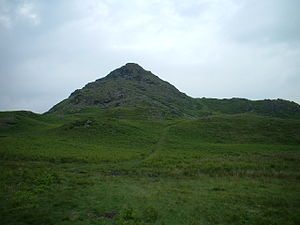Stickle Pike: Difference between revisions
Created page with ':''Not to be confused with the Pike of Stickle'' {{Infobox hill |name=Stickle Pike |county=Lancashire |range=Furness Fells |picture=Sticklepike.jpg |picture caption=Looking t…' |
No edit summary |
||
| (One intermediate revision by the same user not shown) | |||
| Line 1: | Line 1: | ||
{{Hatnote|Not to be confused with the [[Pike of Stickle]]}} | |||
{{Infobox hill | {{Infobox hill | ||
|name=Stickle Pike | |name=Stickle Pike | ||
| Line 5: | Line 5: | ||
|range=Furness Fells | |range=Furness Fells | ||
|picture=Sticklepike.jpg | |picture=Sticklepike.jpg | ||
|picture caption=Looking to Stickle Pike from the continuing southerly ridge to Great Stickle. | |picture caption=Looking to Stickle Pike<br />from the continuing southerly ridge to Great Stickle. | ||
|height=1,230 feet | |height=1,230 feet | ||
|latitude=54.324667 | |||
|longitude=-3.213088 | |||
|os grid ref=SD21209280 | |os grid ref=SD21209280 | ||
}} | }} | ||
'''Stickle Pike''' is an outlying fell of the southern [[Lake District]], in the Dunnerdale Fells, the south-western group of the [[Furness Fells]] of [[Lancashire]] standing close to [[River Duddon|Dunnerdale]]. Stickle Pike is near the small town of [[Broughton-in-Furness]], overlooking Dunnerdale between the lower Duddon Valley and the narrow valley of higher up. | '''Stickle Pike''' is an outlying fell of the southern [[Lake District]], in the Dunnerdale Fells, the south-western group of the [[Furness Fells]] of [[Lancashire]] standing close to [[River Duddon|Dunnerdale]]. Stickle Pike is near the small town of [[Broughton-in-Furness]], overlooking Dunnerdale between the lower Duddon Valley and the narrow valley of higher up. | ||
Despite its low altitude 1,230 | Despite its low altitude of 1,230 feet, the sharp, conical summit is prominent in views from the Broughton and High Furness areas. As with many of the Dunnerdale and Coniston Fells, there are reminders of the area's former mining past in the form of many spoil heaps, disused levels and shafts. The fell is also notable for its superb views despite its low altitude, especially to the [[Scafell]] massif to the north and the sands of the Duddon Estuary to the south. A "stickle" is a hill with a prominent rocky top. | ||
The fell is most easily (and commonly) ascended from the Kiln Bank fell road between Hall Dunnerdale and Broughton Mills, with the top lying less than half a mile from the road summit. An alternative ascent (suggested by Alfred Wainwright) can be made from [[Broughton Mills]] along the [[Great Stickle]]/Tarn Hill ridge, with a return either down the Dunnerdale valley road or by way of the bridleway on the east side of the valley. | The fell is most easily (and commonly) ascended from the Kiln Bank fell road between Hall Dunnerdale and Broughton Mills, with the top lying less than half a mile from the road summit. An alternative ascent (suggested by Alfred Wainwright) can be made from [[Broughton Mills]] along the [[Great Stickle]]/Tarn Hill ridge, with a return either down the Dunnerdale valley road or by way of the bridleway on the east side of the valley. | ||
Latest revision as of 17:19, 31 August 2018
| Stickle Pike | |||
| Lancashire | |||
|---|---|---|---|
 Looking to Stickle Pike from the continuing southerly ridge to Great Stickle. | |||
| Range: | Furness Fells | ||
| Summit: | 1,230 feet SD21209280 54°19’29"N, 3°12’47"W | ||
Stickle Pike is an outlying fell of the southern Lake District, in the Dunnerdale Fells, the south-western group of the Furness Fells of Lancashire standing close to Dunnerdale. Stickle Pike is near the small town of Broughton-in-Furness, overlooking Dunnerdale between the lower Duddon Valley and the narrow valley of higher up.
Despite its low altitude of 1,230 feet, the sharp, conical summit is prominent in views from the Broughton and High Furness areas. As with many of the Dunnerdale and Coniston Fells, there are reminders of the area's former mining past in the form of many spoil heaps, disused levels and shafts. The fell is also notable for its superb views despite its low altitude, especially to the Scafell massif to the north and the sands of the Duddon Estuary to the south. A "stickle" is a hill with a prominent rocky top.
The fell is most easily (and commonly) ascended from the Kiln Bank fell road between Hall Dunnerdale and Broughton Mills, with the top lying less than half a mile from the road summit. An alternative ascent (suggested by Alfred Wainwright) can be made from Broughton Mills along the Great Stickle/Tarn Hill ridge, with a return either down the Dunnerdale valley road or by way of the bridleway on the east side of the valley.
The fell is the subject of a chapter of Wainwright's book The Outlying Fells of Lakeland.[1] His clockwise circuit from Broughton Mills includes Great Stickle at 990 feet, Tarn Hill at 1,231 feet, Stickle Pike, Raven's Crag (called "a nameless summit" by Wainwright) at 1,183 feet, and The Knott at 925 feet, this last sharing its name with The Knott above Hayeswater in the far eastern fells and another outlying fell near Stainton Pike, as well as with Knott north of Skiddaw.
References
- ↑ Wainwright, A. (1974). "Stickle Pike". The Outlying Fells of Lakeland. Kendal: Westmorland Gazette. pp. 126–131.